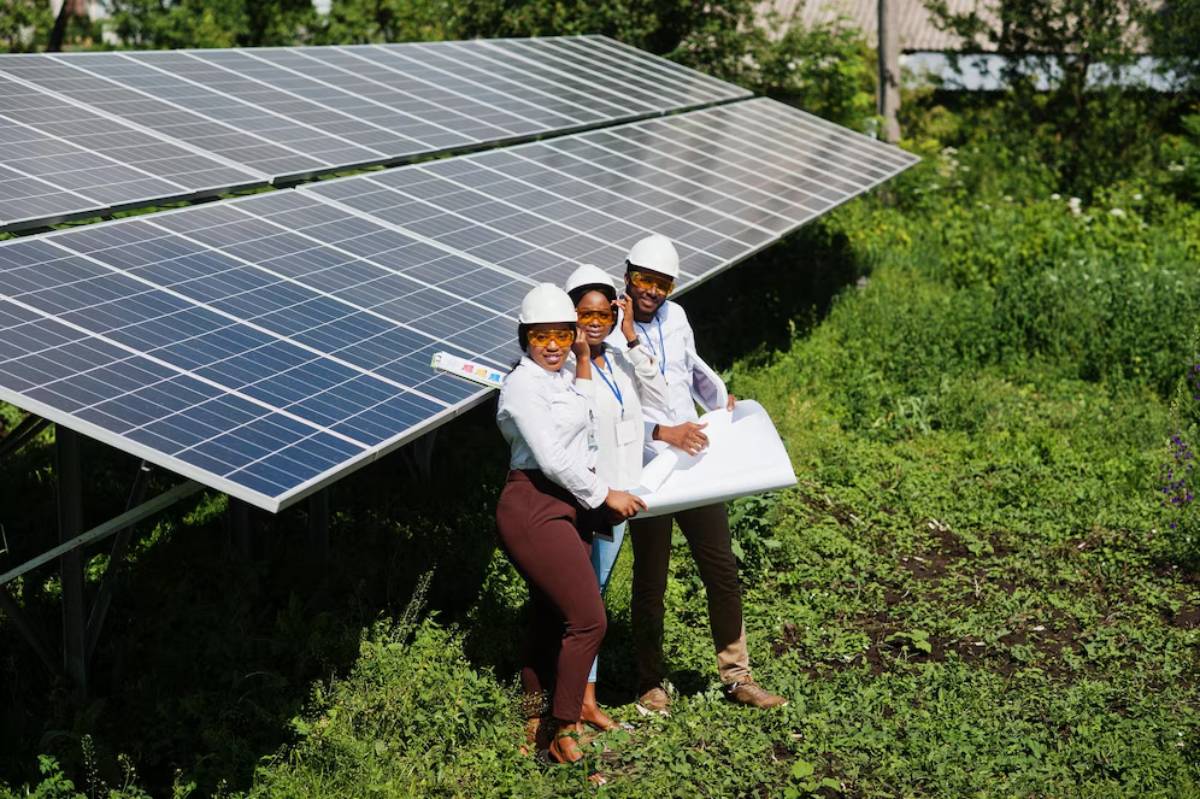The Science Blog

Bioengineered Solutions for Renewable Energy: Pioneering the Future of Sustainable Power
Bioengineered innovations are paving a new way for sustainable energy solutions. Biotechnology and renewable energy intersect to create new solutions for the global energy crisis. This approach can also help reduce environmental harm. This blog looks at how bioengineered solutions are changing renewable energy. It covers the benefits, challenges, and future of this growing area.
The Science Behind Bioengineered Renewable Energy

Bioengineered renewable energy means using genetic and metabolic engineering to create organisms or systems that can produce energy. These include biofuels made from algae, bacteria, yeast, or genetically modified plants. These modifications help boost energy yields. Scientists are customizing organisms to make more ethanol, biodiesel, hydrogen, or electricity. This approach leads to better and greener ways to produce energy.
Bioengineered solutions differ from traditional biofuels. They don’t use much agricultural land or food crops. Instead, they emphasise sustainability. They want to cut down on land-use conflicts, water use, and greenhouse gas emissions. They will do this by using new feedstocks and techniques.
Key Benefits of Bioengineered Renewable Energy Solutions
Bioengineered solutions in renewable energy are not just a futuristic concept; they are a necessity in today’s world. With traditional energy sources running low and harming the environment, sustainable alternatives are more important than ever.
Environmental Impact Reduction
Bioengineered fuels can greatly lower carbon emissions. Bioengineered fuels are different from fossil fuels. They are made to be carbon-neutral, so they don’t release a lot of carbon dioxide into the air. This means the carbon dioxide released during burning is about the same as what the biomass absorbs while it grows. This creates a closed carbon cycle.
Moreover, some bioengineered systems actively remove carbon from the atmosphere. Photosynthetic microbes capture carbon and create energy-rich compounds. This process turns energy generation into a way to sequester carbon.
Resource Efficiency
Bioengineered solutions often use waste materials or non-food biomass. This means they don’t compete with food resources and don’t need a lot of farmland. Using resources efficiently is a key benefit, especially as land and water are getting scarcer.
Using lignocellulosic biomass, like agricultural waste and forestry residues, helps make bioenergy production economical and sustainable. Engineering microbes to digest and convert this biomass efficiently boosts the process.
Energy Security
Countries can boost their energy security by diversifying their energy portfolio with bioengineered fuels. Using a mix of renewable energy sources, like biotech innovations, lowers the need for imported fossil fuels. This also protects economies from unstable global energy markets.
This decentralized way of making energy helps rural and remote areas. It lets them produce power locally using biomass and microbial fuel cells.
Economic Opportunities
The development and implementation of bioengineered renewable energy technologies create new economic opportunities. This sector can create jobs and boost the economy. It’s especially important for rural and less developed areas.
Biomass supply chains, bio-refinery construction, and biotech start-ups are key parts of the green economy. They can help boost future job markets.
Why Bioengineered Solutions Matter Now More Than Ever
The need to switch to renewable energy is clear. Climate change is happening faster than ever. Bioengineered solutions can help meet sustainability goals. They support global efforts like the Paris Agreement, which aims to limit global warming.
As more people and industries need energy, we can’t keep using limited and polluting fossil fuels. Bioengineered systems help connect our energy needs with climate responsibility.
Real-life Applications and Innovations
Several groundbreaking projects highlight the potential of bioengineered solutions in renewable energy.
For instance, the development of algae-based biofuels represents a significant step forward. Algae have a high lipid content, which can be converted into biodiesel, and they grow rapidly, making them an efficient biomass source. Pilot projects in the UK and beyond are already demonstrating the feasibility of scaling up algae biofuel production.
Another promising innovation is the use of genetically modified microbes to produce bioethanol. These microbes are designed to turn plant biomass into ethanol. Ethanol is a renewable fuel that powers vehicles and has low environmental impact. This technology is great because it uses agricultural waste. This cuts down on waste and boosts the sustainability of biofuel production.
Microbial fuel cells (MFCs) use bacteria’s natural processes to produce electricity. They are currently being developed further. These systems provide cheap, decentralized power. They’re great for wastewater treatment plants and off-grid communities.
Additional Expert Tips & Common Mistakes to Avoid
The potential of bioengineered renewable energy is huge. However, it’s important to follow best practices and avoid common pitfalls:
Best Practices
- Invest in Research and Development: Ongoing R&D investment is key. It helps tackle technical challenges and boosts the efficiency of bioengineered fuels.
- Focus on Scalability: Many bioengineered solutions look good in small batches, but we need to increase production to really affect energy markets.
- Support Renewable Energy: Government policies like subsidies and tax incentives can speed up the use of bioengineered solutions.
- Use Integrated Systems Thinking: To succeed, see bioenergy as part of larger energy and environmental systems. Consider infrastructure, logistics, and ecological balance.
Common Mistakes
- Ignoring Life Cycle Analysis: Not doing full life cycle analyses can underestimate the environmental effects of bioengineered fuels.
- Overlooking Public Perception: Public acceptance is key for the widespread use of bioengineered solutions. Transparent communication about benefits and safety is essential.
- Ignoring Integration Challenges: Integrating bioengineered fuels into current energy systems needs careful planning and infrastructure work.
- Underestimating Economic Viability: Start-ups and governments should do feasibility studies. This helps ensure they stay cost-competitive with other renewables in the long run.
Advanced Insights and Expert Recommendations
To fully use bioengineered solutions for renewable energy, we need a multi-faceted approach. Here are some advanced insights and recommendations from industry experts:
Embrace Synthetic Biology
Synthetic biology opens up new ways to make custom organisms. These organisms can efficiently produce specific biofuels. Researchers can improve yield and cut costs by designing microbes with better metabolic pathways.
CRISPR and other gene-editing tools have sped up microbial engineering. They allow for exact changes and quick testing of energy-producing strains.
Develop Hybrid Systems
Using bioengineered solutions along with solar or wind energy can form hybrid systems. These systems boost energy output and improve reliability. These systems offer a steadier energy supply. This helps solve a big challenge for renewable energy sources.
Bioenergy can supply power when solar or wind energy is low. This helps keep the grid stable.
Foster International Collaboration
Given the global nature of energy and environmental challenges, international collaboration is vital. Sharing knowledge, technology, and resources can speed up the growth of bioengineered renewable energy solutions around the world.
Joint ventures, cross-border research programs, and international funding are key to boosting biotech energy solutions.
Standardise Regulation and Safety Protocols
Harmonized rules and safety standards help international trade. They also ensure environmental compliance and build public trust in bioengineered products.
Governments need to balance innovation with ecosystem protection. They should use strong but flexible biosafety measures.
Conclusion: Shaping a Sustainable Future with Bioengineered Renewable Energy

The journey towards a sustainable energy future is complex. Bioengineered solutions offer a promising pathway. These innovations can change the renewable energy landscape. They tackle environmental, economic, and energy security challenges. As we develop these technologies, we must stay focused on sustainable practices. Supportive policies and international teamwork are also key.
In conclusion, bioengineered solutions for renewable energy are not just an academic exercise. They are a critical component of a sustainable future. As we welcome these innovations, we must think about their wider effects. We should aim for a world where renewable energy is easy to access, efficient, and good for the environment.
What steps will you take to support the transition to bioengineered renewable energy? Share your thoughts and join the conversation on sustainable energy solutions.









